1995 CADILLAC FLEETWOOD brakes
[x] Cancel search: brakesPage 11 of 306
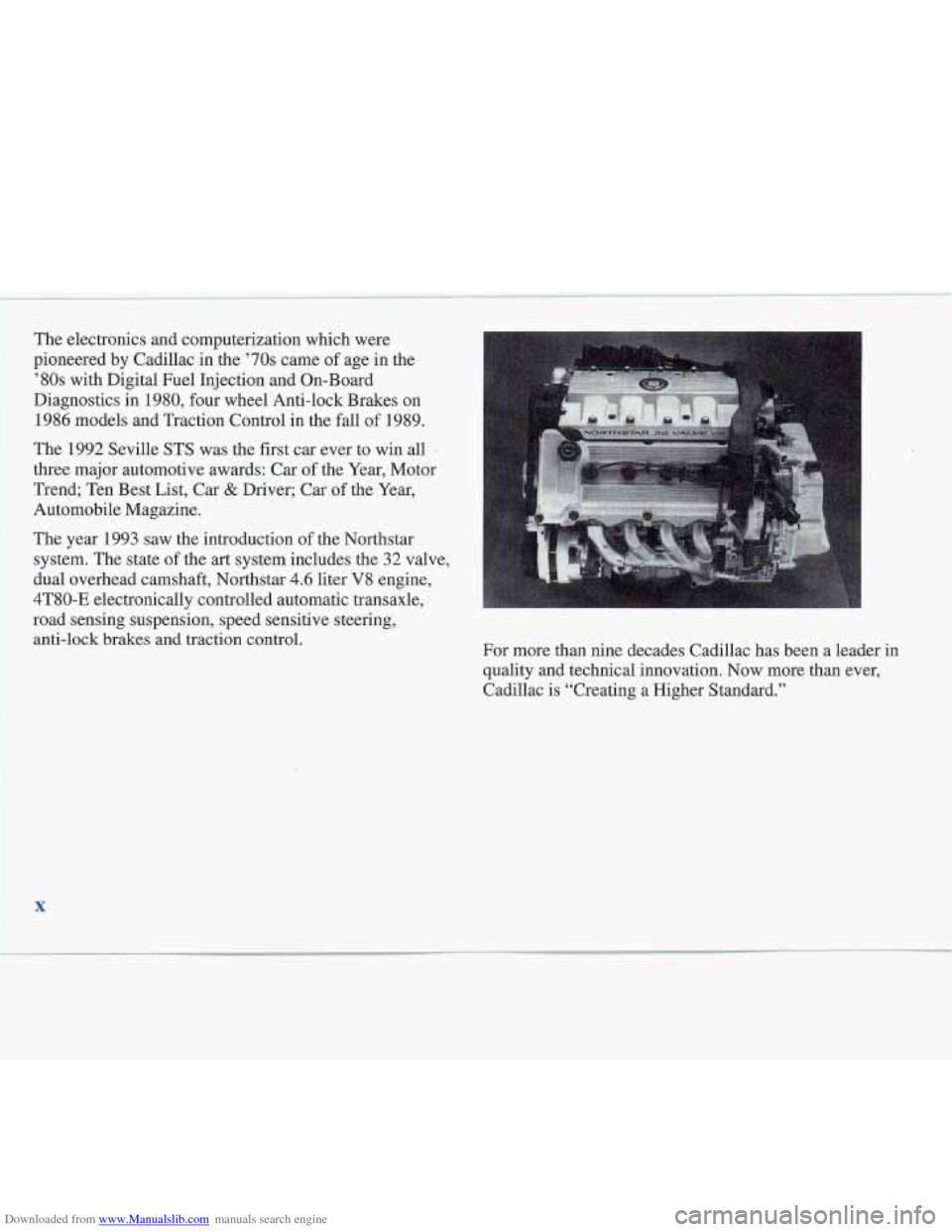
Downloaded from www.Manualslib.com manuals search engine The electronics and computerization which were
pioneered by Cadillac in the
’70s came of age in the
’80s with Digital Fuel Injection and On-Board
Diagnostics in
1980, four wheel Anti-lock Brakes on
1986 models and Traction Control in the fall of 1989.
The 1992 Seville STS was the fist car ever to win all
three major automotive awards: Car
of the Year, Motor
Trend; Ten Best List, Car
& Driver; Car of the Year,
Automobile Magazine.
The year
1993 saw the introduction of the Northstar
system. The state of the art system includes the
32 valve,
dual overhead camshaft, Northstar
4.6 liter V8 engine,
4T80-E electronically controlled automatic transaxle,
road sensing suspension, speed sensitive steering, anti-lock brakes and traction control.
X
For more than nine decades Cadillac has been a leader in
quality and technical innovation. Now more than ever,
Cadillac is “Creating
a Higher Standard.”
Page 14 of 306
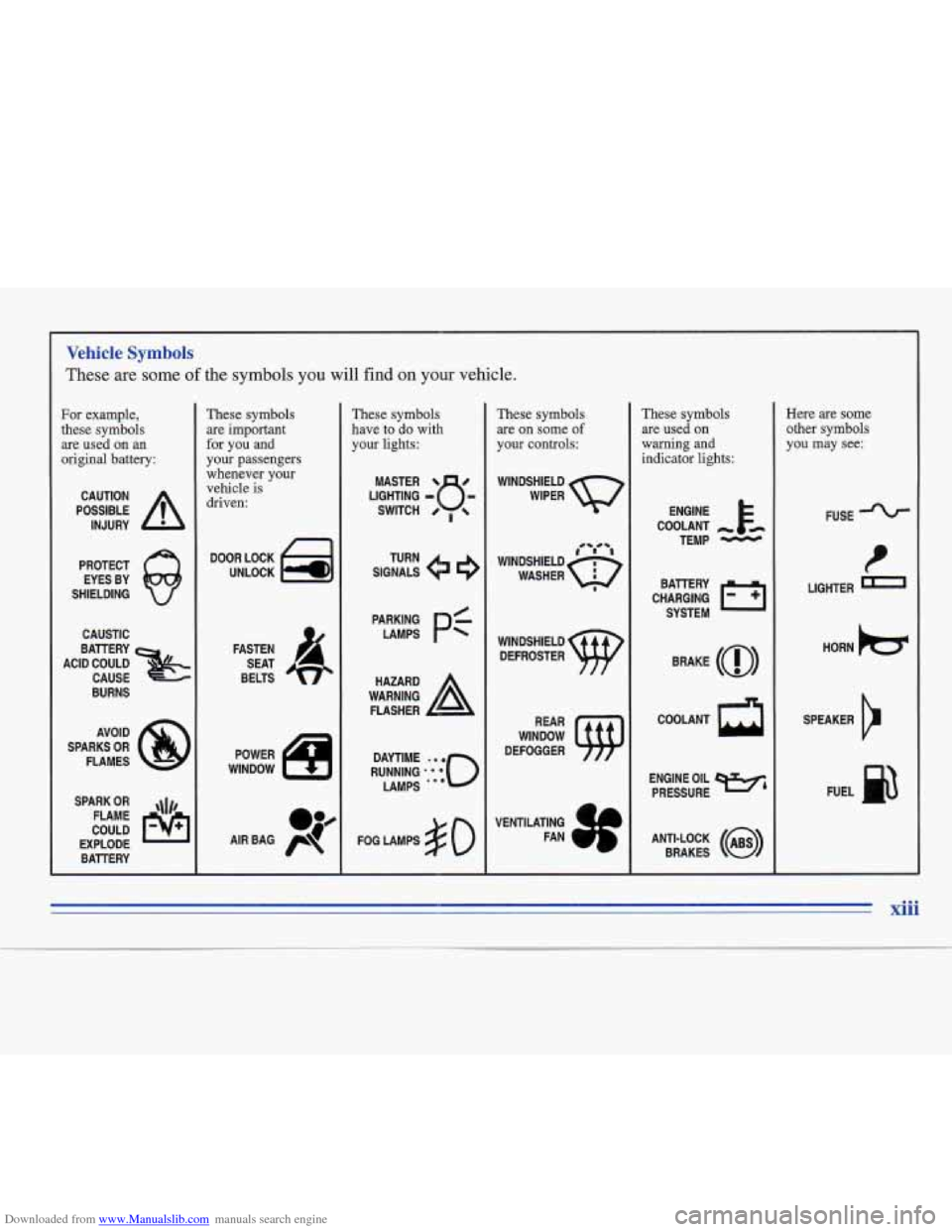
Downloaded from www.Manualslib.com manuals search engine Vehicle Symbols
These are some of the symbols you will find on your vehicle.
For example,
these symbols
are used on an
original battery:
POSSIBLE A
CAUTION
INJURY
PROTECT EYES BY
SHIELDING
CAUSTIC
ACID COULD
&
BAllERY
CAUSE
BURNS
AVOID
SPARKS
OR
FLAMES
SPARK
OR ,\I/,
COULD FLAME
EXPLODE BATTERY
These symbols are important
for you and
your passengers
whenever your
vehicle
is
driven:
DOOR LOCK
UNLOCK
FASTEN SEAT
BELTS
POWER
WINDOW
These symbols
have to do with
your lights:
SIGNALS e
TURN
PAERK pf
FOG LAMPS $0
These symbols
are on some
of
your controls:
WIPER w
WINDSHIELD
DEFROSTER
WINDOW
DEFOGGER
VENTILATING FAN
These symbols are used
on
warning and
indicator lights:
COOLANT
TEMP
-
CHARGING Tql
BAllERY
SYSTEM
BRAKE
(0)
COOLANT a
ENGINE OIL e,
PRESSURE
ANTI-LOCK
(a)
BRAKES
Here are some
other symbols
you may see:
FUSE -%-
t
LIGHTER m
HORN )cr
SPEAKER
b
FUEL e3
xiii
Page 80 of 306
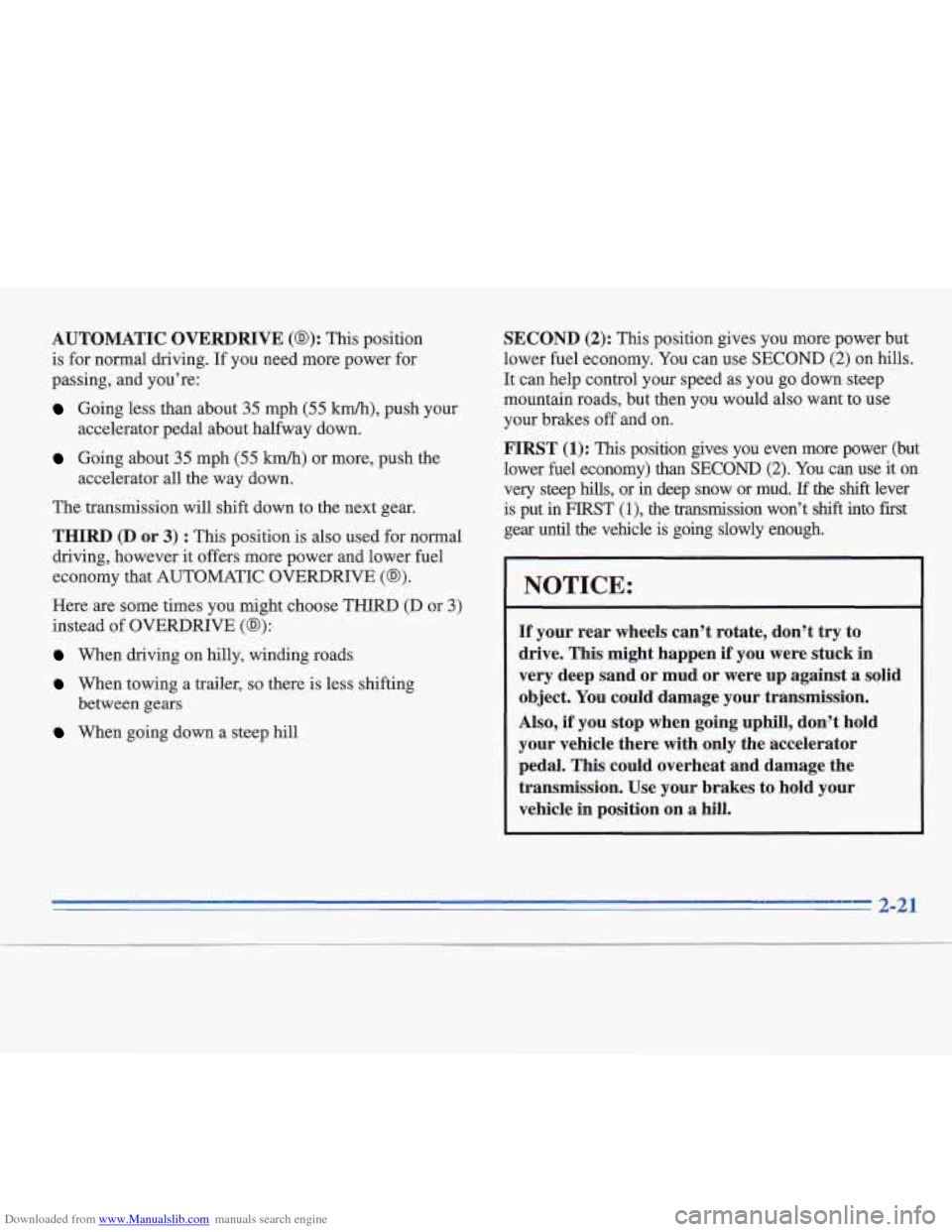
Downloaded from www.Manualslib.com manuals search engine AUTOMATIC OVERDRIVE (@): This position
is for normal driving.
If you need more power for
passing, and you’re:
Going less than about 35 mph (55 km/h), push your
Going about 35 mph (55 km/h) or more, push the
The transmission will shift down to the next gear.
accelerator pedal
about halfway down.
accelerator all the way down.
THIRD (D or 3) : This position is also used for normal
driving, however it offers more power and lower fuel
economy that AUTOMATIC OVERDRIVE
(@).
Here are some times you might choose THIRD (D or 3)
instead of OVERDRIVE (@):
When driving on hilly, winding roads
When towing a trailer, so there is less shifting
When going down a steep hill
between gears
SECOND (2): This position gives you more power but
lower fuel economy. You can use SECOND
(2) on hills.
It can help control your speed as you
go down steep
mountain roads, but then you would
also want to use
your brakes
off and on.
FIRST (1): This position gives you even more power (but
lower fuel economy)
than SECOND (2). You can use it on
very steep hills, or in deep snow or mud. If the shift lever
is put in
FIRST (l), the transmission won’t shift into first
gear until the vehicle is going slowly enough.
NOTICE:
If your rear wheels can’t rotate, don’t try to
drive. This might happen
if you were stuck in
very deep sand
or mud or were up against a solid
object. You could damage your transmission.
Also,
if you stop when going uphill, don’t hold
your vehicle there with only the accelerator
pedal. This could overheat and damage the
transmission. Use your brakes to hold your
vehicle in position on a hill.
Page 85 of 306
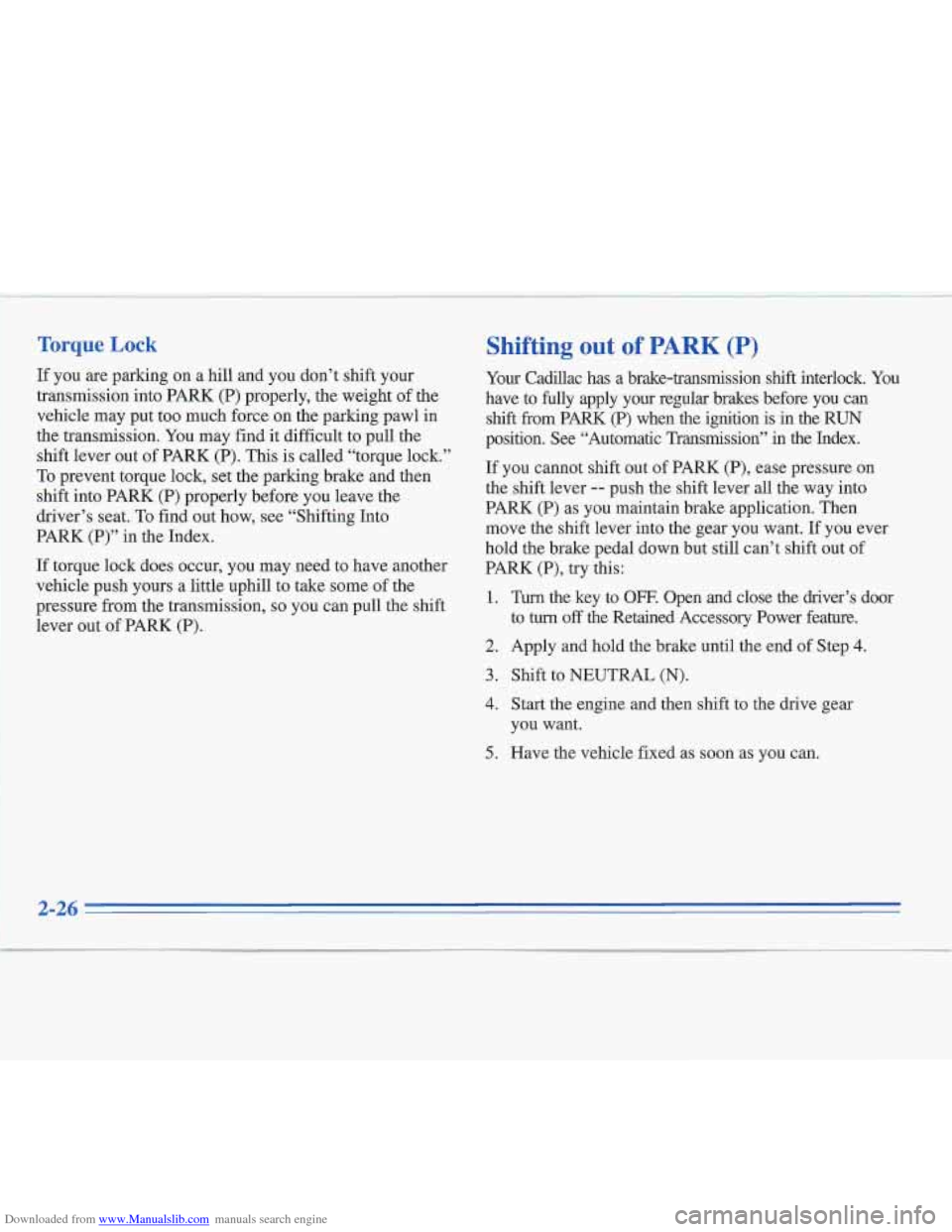
Downloaded from www.Manualslib.com manuals search engine Toraue Lock
11 you are parking on a hill and you don’t shift your
transmission into PARR (P) properly, the weight of the
vehicle may put too much force on the parking pawl in
the transmission.
You may find it difficult to pull the
shift lever out of PARK (P). This is called “torque lock.”
To prevent torque lock, set the parking brake and then
shift into PARK (P) properly before you leave the
driver’s seat. To find
out how, see “Shifting Into
PARK
(P)” in the Index.
If torque lock does occur, you may need to have another
vehicle push yours a little uphill to take some
of the
pressure from the transmission,
so you can pull the shift
lever out of PARK
(P).
Shifting out of PARK (P)
Your Cadillac has a brake-transmission shift interlock. You
have to fully apply your regular brakes before you can
shift from PARK (P) when the ignition is in the RUN
position. See “Automatic Transmission” in the Index.
If you cannot shift out of PARK (P), ease pressure on
the shift lever
-- push the shift lever all the way into
PARK
(P) as you maintain brake application. Then
move the shift lever into the gear you want.
If you ever
hold the brake pedal down but still can’t shift out of
PARK (P), try this:
1. Turn the key to OFF. Open and close the driver’s door
to
twn off the Retained Accessory Power feature.
2. Apply and hold the brake until the end of Step 4.
3. Shift to NEUTRAL (N).
4. Start the engine and then shift to the drive gear
you want.
5. Have the vehicle fixed as soon as you can.
2-26
Page 93 of 306
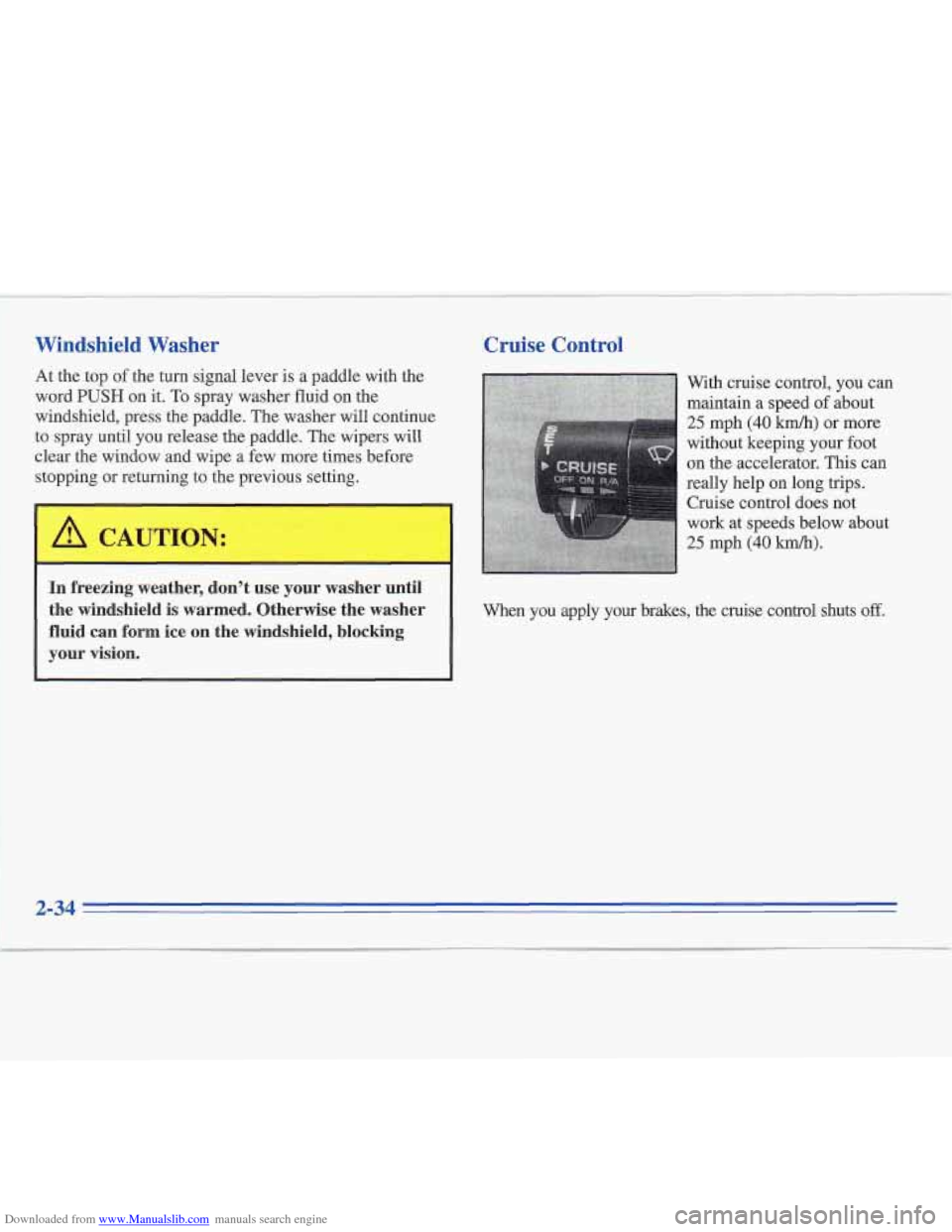
Downloaded from www.Manualslib.com manuals search engine Windshield Washer
At the top of the turn signal lever is a paddle with the
word
PUSH on it. To spray washer fluid on the
windshield, press the paddle. The washer will continue
to spray until you release the paddle. The wipers will
clear the window and wipe a few more times before
stopping
or returning to the previous setting.
Cruise Control
_In freezing weather, don’t use your washer until
the windshield is warmed. Otherwise the washer
fluid can form ice on the windshield, blocking
your vision.
With cruise control, you can
maintain a speed
of about
25 mph (40 km/h) or more
without keeping your foot
on the accelerator. This can
really help on long trips. Cruise control does not
work at speeds below about
25 mph (40 km/h).
When you apply your brakes, the cruise control shuts off.
Page 116 of 306
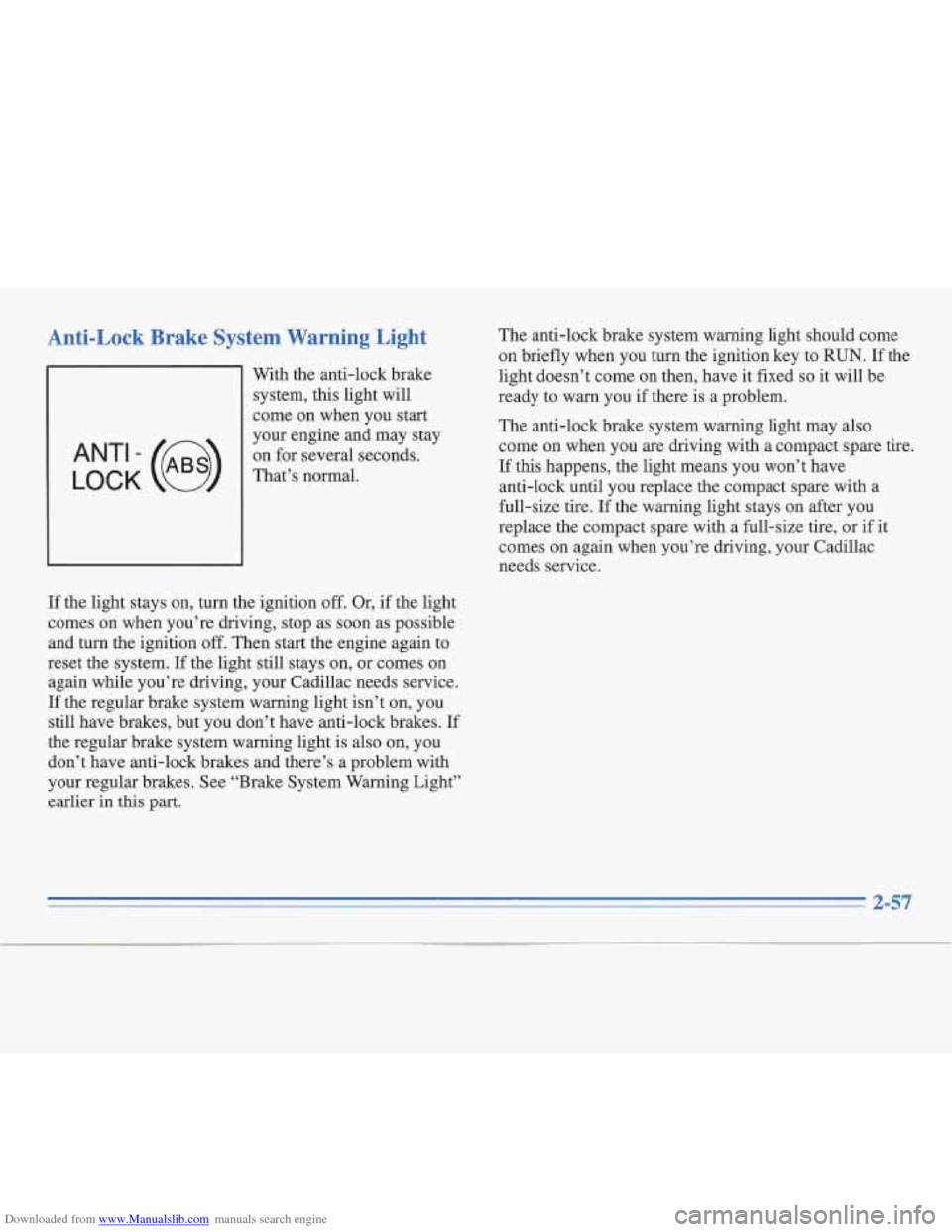
Downloaded from www.Manualslib.com manuals search engine Anti-Lock Brake System Warning Light
With the anti-lock brake
system, this light will
come on when you start
your engine and may stay
LOCK ANT‘- (e) That’s on for several normal. seconds.
If the light stays on,
turn the ignition off. Or, if the light
comes on when you’re driving, stop as soon as possible
and
turn the ignition off. Then start the engine again to
reset the system.
If the light still stays on, or comes on
again while you’re driving, your Cadillac needs service.
If the regular brake system warning light isn’t on, you
still have brakes, but you don’t have anti-lock brakes. If
the regular brake system warning light
is also on, you
don’t have anti-lock brakes and there’s a problem with
your regular brakes. See “Brake System Warning Light”
earlier in this part. The
anti-lock brake system warning light should come
on briefly when you turn the ignition key to
RUN. If the
light doesn’t come on then, have
it fixed so it will be
ready to warn you
if there is a problem.
The anti-lock brake system warning light may also
come on when you are driving with a compact spare tire.
If this happens, the light means you won’t have
anti-lock until you replace the compact spare with a
full-size tire. If the warning light stays on after you
replace the compact spare with a full-size tire, or if it
comes on again when you’re driving, your Cadillac
needs service.
2-57
Page 151 of 306

Downloaded from www.Manualslib.com manuals search engine Avoid needless heavy braking. Some people drive in
spurts
-- heavy acceleration followed by heavy
braking
-- rather than keeping pace with traffic. This is a
mistake. Your brakes may not have time to cool between
hard stops. Your brakes will wear out much faster if you
do a lot of heavy braking. If you keep pace with the
traffic and allow realistic following distances, you will
eliminate a lot of unnecessary braking. That means
better braking and longer brake life.
If your engine ever stops while you’re driving, brake
normally but don’t pump your brakes. If you do, the
pedal may get harder to push down.
If your engine
stops, you will still have some power brake assist. But
you will use it when you brake. Once the power assist is
used up,
it may take longer to stop and the brake pedal
will be harder to push.
Anti-Lock Brakes
Your vehicle has anti-lock brakes (ABS). ABS is an
advanced electronic braking system that will help
prevent a braking skid.
When you start your engine and begin to drive away,
your anti-lock brake system will check itself. You may
hear a momentary motor or clicking noise while this test
is going on, and you may even notice that your brake
pedal moves a little. This is normal.
LOCK
ANT‘- (e)
If there’s a problem with the
anti-lock brake system, this
warning light will stay on. See “Anti-Lock Brake
System Warning Light’’ in
the Index.
4-6
Page 152 of 306
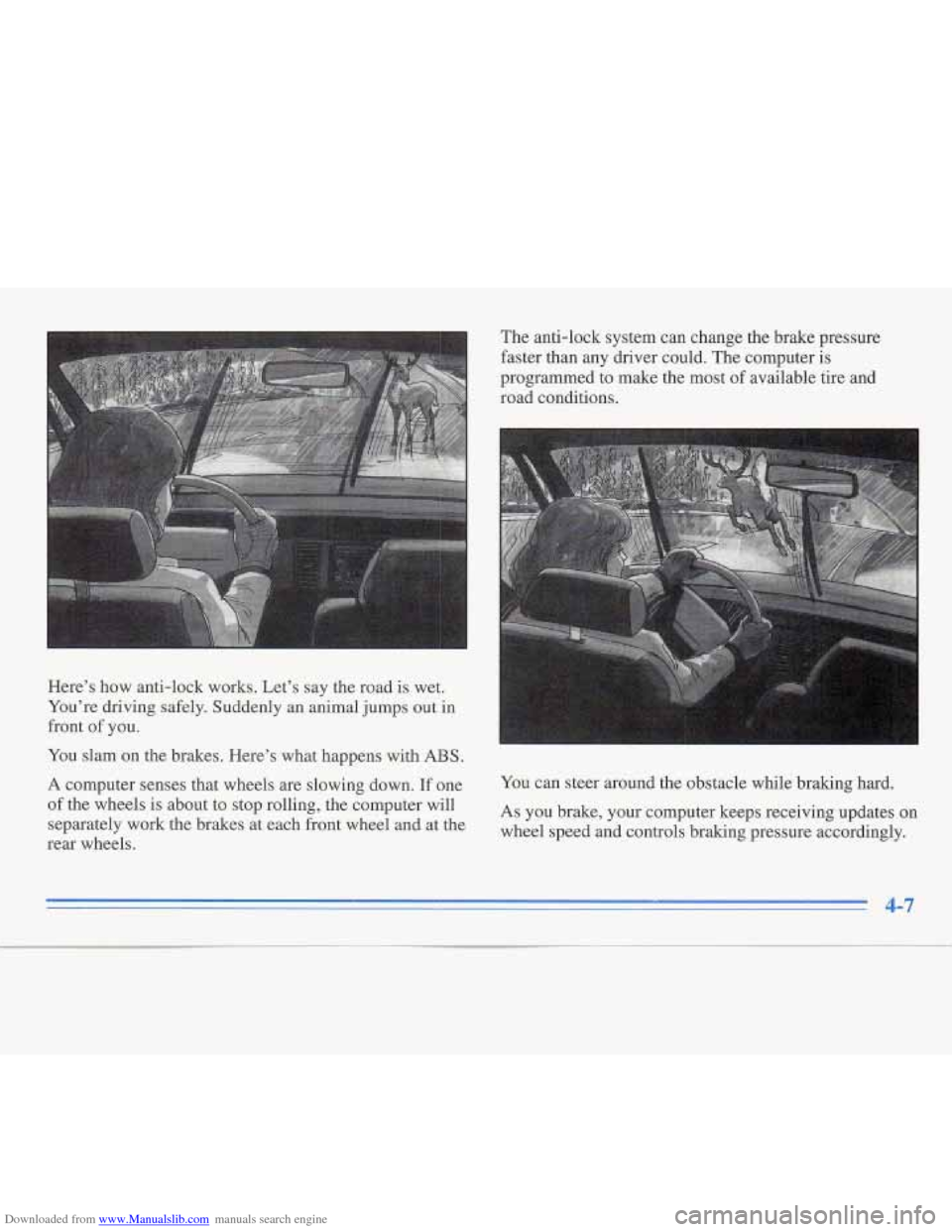
Downloaded from www.Manualslib.com manuals search engine The anti-lock system can change the brake pressure
faster than anv driver could. The commter is
.’ I
programmed to make the most of available tire and
road conditions.
1
Here’s how anti-lock works. Let’s say the road is wet.
You’re driving safely. Suddenly an animal jumps out in
front
of you.
You slam
on the brakes. Here’s what happens with ABS.